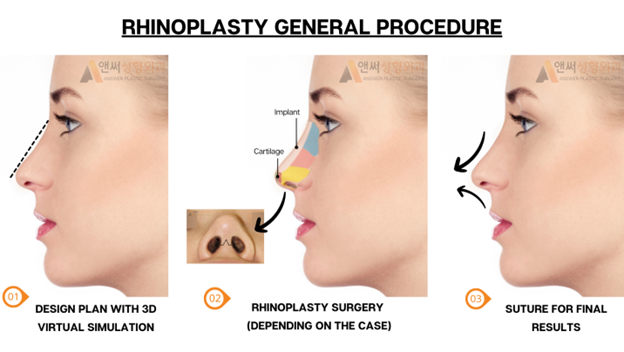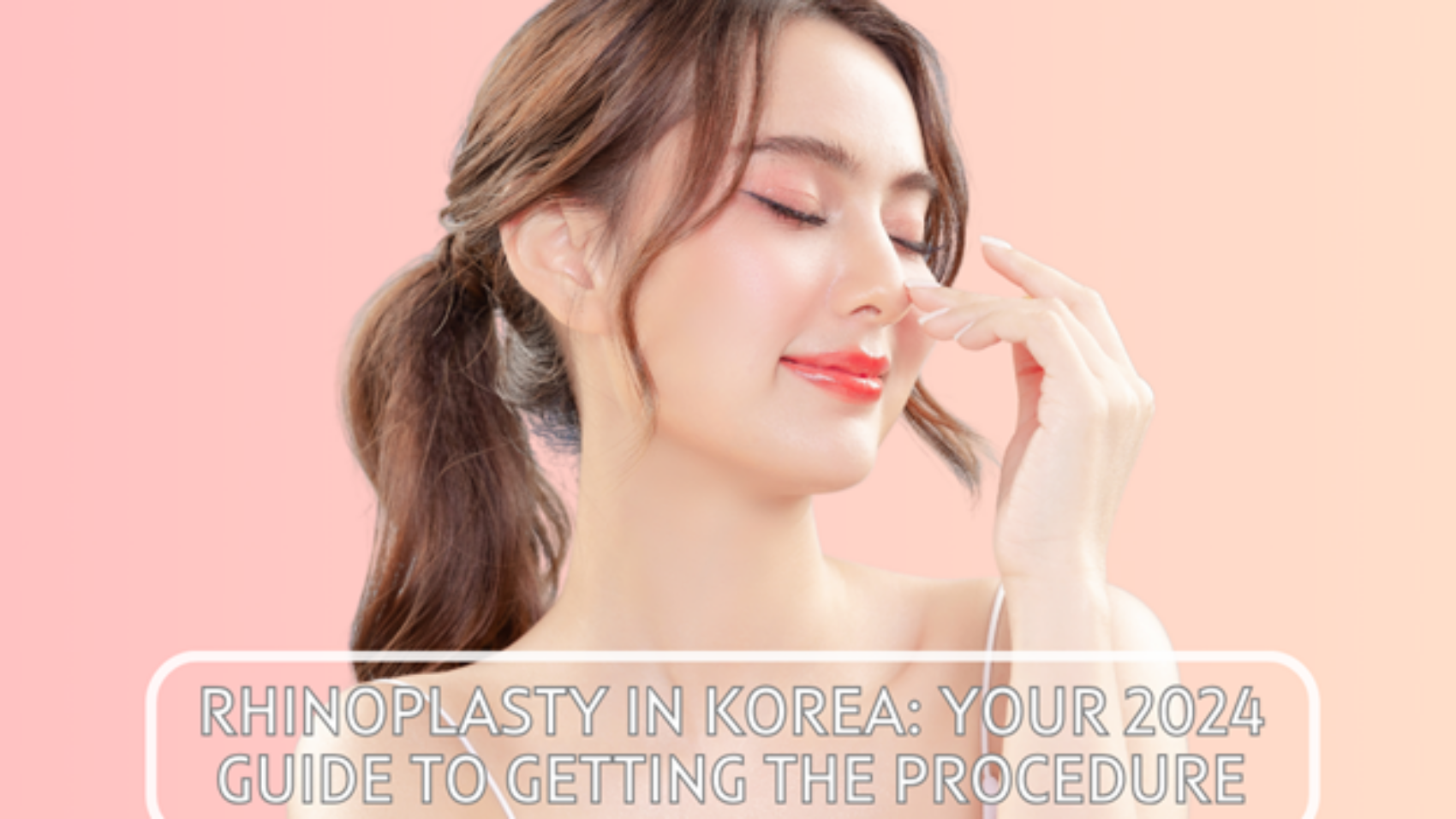South Korea is the ideal destination for high-quality skincare products and cutting-edge face-contouring techniques. They are regarded as the most sought-after location among their neighboring nations when it comes to getting successful and reasonably priced plastic surgery. This is why they have earned the title of the “Cosmetic Surgery Capital of the World.” Korea is also 5th place with the most significant number of plastic surgeons and the highest per-person percentage of plastic surgeries in the world, where rhinoplasty is the top cosmetic surgery being performed in the country.
Rhinoplasty in Korea is a facial contouring surgery where it invasively improves or alters the shape and alignment of the nose. Most plastic surgeons use the Golden Ratio to determine the patient’s ideal nose shape. The nose’s appearance makes or breaks how one looks. It can change one’s appearance as the nose sits at the center of the face. Thus, some prefer surgery to enhance their nose shape to create a more balanced and proportionate look.
This article will help you get a general idea of rhinoplasty. We will also give you a step-by-step process for getting a nose job in South Korea if you ever decide to achieve your aesthetic goals in 2024!
WHAT IS RHINOPLASTY?

Rhinoplasty in Korea is the surgical alteration or enhancement of the nose. It entails using various prosthetic and implant materials to repair and improve the nose. Rhinoplasty, also known as a nose job, is one of the most popular surgical procedures in South Korea. It consists of several treatments that use precise incisions to create a symmetrical and natural-looking nose. With an accurate diagnosis of the overall features, the type of rhinoplasty method will be determined to suit the facial design and preference of the patient. To produce a balanced and harmonious result, a rhinoplasty specialist must evaluate the overall nasal structure and facial anatomy. Treating only one isolated part of the nose may lead to imbalanced outcomes. However, it will still depend on a case-by-case basis where only tip plasty or nose bridge augmentation is enough to create natural results.
Rhinoplasty is considered a major plastic surgery; hence, it can carry risks and complications such as bleeding, infection, swelling, a perforated septum, and an uneven-looking nose. However, with a qualified and experienced plastic surgeon like Dr. Min Choi of Answer Plastic Surgery, these risks are greatly decreased. The adverse effects of surgery are minimal and are expected to diminish after a few days or months.
Korean Rhinoplasty is available to both men and women who want to improve the form and size of their noses to create more appealing and proportionate facial characteristics. Furthermore, rhinoplasty focuses on the nose’s appearance and functional features. For example, rhinoplasty can correct a deviated septum, which frequently causes breathing problems. It is critical to understand that each individual has a unique anatomical structure that necessitates a personalized surgical design plan created by a board-certified and professional plastic surgeon. At Answer Plastic Surgery in Korea, Dr. Min Choi, the founder and head surgeon, performs 1:1 consultations for an in-depth nose assessment and to determine the best rhinoplasty procedure that will align with your goals.
HOW IS RHINOPLASTY DONE?
Rhinoplasty in Korea follows a standard measurement called the Golden Ratio. Although it is not the sole basis for determining the best nose shape and size for the patient, it can guide the surgeon in assessing what suits them best. According to the Golden Ratio standard, an ideal nose will show proportionate measurements of the nose’s height from the forehead to the nose bridge with a 115°~130° angle and from the nose tip to the upper lip with a 95°~100° angle. The width of the nasal wings must also be in line with the brows, roughly creating that 1:1.618 ideal ratio. To achieve this, Dr. Choi creates a design plan after assessing the patient’s nose through a virtual simulation of how the ideal nose of the patient would look after undergoing rhinoplasty.

Dr. Choi will also determine what type of rhinoplasty method will be used. For example, if you have a hump on your nose, the best procedure for you would be a hump removal rhinoplasty. Furthermore, implants and prostheses such as cartilage can be utilized to augment and form the desired nose shape. Among the available implant materials in the market, silicon is the most common due to its durability and affordability. In contrast, the most widely used prostheses are autologous cartilage extracted from the patient’s ear, septum, or rib cage.
As stated before, Korean Rhinoplasty comprises several methods depending on the nose’s condition. Each method uses a unique surgical strategy and technique to get the desired result. Generally, Rhinoplasty in Korea often begins with a thorough consultation and surgical design plan. Depending on the situation, the surgeon will perform the selected rhinoplasty operation or a combination of them. Finally, the incision will be carefully sutured to avoid scarring.

Furthermore, there are two main incision techniques for correcting nose shape: closed and open rhinoplasty. Most plastic surgeons in South Korea prefer the open rhinoplasty approach because of its multiple benefits, including easier access to the underlying nasal anatomy, which allows for more surgical precision. However, the closed rhinoplasty method is also employed when minor modifications are only needed for shorter periods of surgery.
WHAT TYPE OF RHINOPLASTY IS BEST FOR YOU?
Creating the desired nose shape and size will need a series of surgical techniques such as bone cutting (osteotomy), augmenting using implants, and correcting with cartilage prostheses. Dr. Choi will thoroughly evaluate your nose and take into account your preferences and aesthetic goals. Along with his recommendations, he will create a customized treatment plan for you that may include a combination of rhinoplasty procedures to target the overall nose structure for a more harmonious appearance.
The different types of rhinoplasty procedures offered at Answer Plastic Surgery in South Korea range from humped nose removal to nose revision surgeries. You may take a look at more comprehensive details of each procedure on our website here. Below is a brief rundown of each procedure, from hump resection and deviated nose correction to augmentation rhinoplasty with implants or cartilage, and what each is best used for to give you an idea before deciding to undergo rhinoplasty in Korea.

A COMPLETE GUIDE ON HOW TO GET RHINOPLASTY IN SOUTH KOREA
When you understand the concept of getting a rhinoplasty procedure, you can now make informed decisions about whether it is worth undergoing a nose job. It is a big decision, but we are here to help you get a head start. If you have more in-depth inquiries about rhinoplasty, you can contact our customer service or leave a message on our social media accounts, and we will do our best to answer your questions.
Here is a complete guide on how to get rhinoplasty in Korea at the most reasonable cost with successful results.
- You can utilize our FREE online consultation service to ask questions about the procedure, surgical expenses, and specific concerns. If the surgery terms satisfy you, you can schedule an appointment, and we will set up a face-to-face consultation with Dr. Choi and the surgery date.
- Once you have a scheduled appointment and if you are residing abroad, you can now book a flight to South Korea! You will also need to book accommodation, preferably near the clinic, to make it more convenient. Click here for a transportation guide to our clinic location. Additionally, suppose you want less hassle during your stay in Korea. In that case, our collaboration with Seoul Guide Medical allows you several perks, such as airport pick-up, securing accommodations, and help with transportation.
- Depending on your surgery case, the length of your stay in South Korea will vary but can range from 8 to 10 days. Generally, the first day will consist of a full and direct consultation with Dr. Min Choi. Then, the next day will be your final consultation before the surgery begins.
- The final consultation will include a series of pre-surgery tests and evaluations conducted by one of our staff. This is to rule out any potential infection and prevent complications during your surgery. It is also highly recommended that you consider all the precautions before you undergo a major surgery like rhinoplasty, such as avoiding smoking cigarettes and drinking alcohol for at least 2 to 4 weeks.
- The surgery is estimated to last for 2 to 3 hours but may vary depending on your treatment plan. Anesthesia is often given before surgery to facilitate the incision without feeling pain or discomfort. After your surgery, you will have to rest in our recovery room for 1 to 2 hours to wean you off entirely from the anesthesia.
- You may experience swelling and bruising after surgery, but this can be reduced with our aftercare services. You will be advised to return to the clinic the next day for your first follow-up check-up. Additional check-ups will be scheduled 2 to 3 more times according to your recovery progress.
- In about 8 to 10 days, all the stitches from the incision will be removed. You will also receive aftercare services like our Red-Light Therapy to boost your skin’s healing process. Medications such as painkillers and antibiotics will also be given to you to facilitate your recovery.
- By this time, you can either stay longer in South Korea to see the sights or fly back home! If you have more questions regarding your surgery and recovery, you can always contact us through our website or any of our social media channels, and we will be glad to answer any inquiries.
How useful was this post?
Click on a star to rate it!
Average rating 0 / 5. Vote count: 0
No votes so far! Be the first to rate this post.

